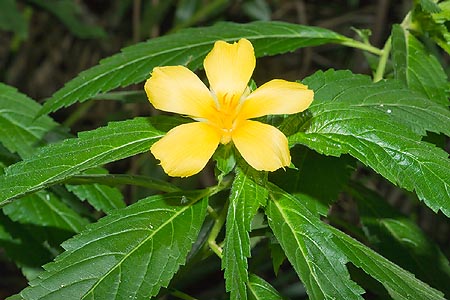Family : Passifloraceae

Text © Pietro Puccio

English translation by Mario Beltramini

Very spread in the Tropics also for its medical virtues © Giuseppe Mazza
The Turnera ulmifolia L. (1753) is native to the southern USA (Florida), Central America (Belize, Costa Rica, Honduras, Mexico, Nicaragua and Panama) and the Caribbean area (Dutch Antilles, Bahamas, Bermuda, Cuba, Guadeloupe, Haiti, Jamaica, Martinique, Puerto Rico, Cayman Islands, Turks and Caicos Islands, Virgin Islands, Dominican Republic, Trinidad and Tobago).
The genus is honoured to the English physician and botanist William Turner (1510-1568); the name of the species is the combination of the Latin names “ulmus” = elm and “folium” = leaf, with reference to the shape of the leaves.
Common names: “yellow buttercups”, “sage-rose”, “west Indian-holly”, “yellow-alder”, “ramgoat dashalong” (English); “Ulmenblättrige”, “Grossblättrige Damiana” (German); “marilope”, “flor amarilla”, “san Lorenzo”, “damiana guerrero” (Spanish); “chanana”, “turnera-de-folha-olmo”, “erva-damiana”, “flor-do-guaruja” (Portuguese).
Perennial herbaceous or small evergreen shrub, compact, tall up to about 1,5 metres, with ovate lanceolate leaves, slightly rough, of a glossy dark green colour, long up to about 12 cm and 3-4 cm broad, with regular veins and jagged margin; at the base of the petiole there are two small nectar glands. The fruits are axillar, ephemeral, but continuously produced, of an intense yellow colour, of about 6 cm of diameter. The fruits are ovoid, 6-8 mm long capsules, containing slightly bent seeds, long 2-3 mm. It easily propagates by seed, cutting and air layering.
Very diffused in the wild, particularly in sandy locations, and appreciated as ornamental plant due to its bright yellow flowers which catch the eye against the dark green foliage. Can be cultivated in tropical, subtropical and warm temperate climates, preferably in full sun; it is not particular in soil, provided the same is very draining. Leaves and roots are utilized since the old times in the traditional medicine.
Synonyms: Turnera angustifolia Mill. (1768); Turnera ulmifolia var. angustifolia (Mill.) Willd. (1798); Turnera peruviana Willd. ex Roem. & Schult. (1820); Turnera trioniflora Sims (1820); Turnera mollis Kunth (1823); Turnera caerulea DC. (1828); Turnera velutina C. Presl (1831); Turnera alba Liebm. (1848); Turnera ulmifolia var. velutina (C. Presl) Urb. (1883).
→ To appreciate the biodiversity within PASSIFLORACEAE family please click here.
